Exploring The Relative Astringency of Tea Catechins and Distinct Astringent Sensation of Catechins and Flavonol Glycosides via an In Vitro Assay Composed of Artificial Oil Bodies
- PMID: 36080445
- PMCID: PMC9457659
- DOI: 10.3390/molecules27175679
Exploring The Relative Astringency of Tea Catechins and Distinct Astringent Sensation of Catechins and Flavonol Glycosides via an In Vitro Assay Composed of Artificial Oil Bodies
Abstract
Artificial oil bodies covered by a recombinant surface protein, caleosin fused with histatin 3 (a major human salivary peptide), were employed to explore the relative astringency of eight tea catechins. The results showed that gallate-type catechins were more astringent than non-gallate-type catechins, with an astringency order of epicatechin gallate > epigallocatechin gallate > gallocatechin gallate > catechin gallate > epigallocatechin > epicatechin > gallocatechin > catechin. As expected, the extension of brewing time led to an increase in catechin content in the tea infusion, thus elevating tea astringency. Detailed analysis showed that the enhanced proportion of gallate-type catechins was significantly higher than that of non-gallate-type catechins, indicating that tea astringency was elevated exponentially, rather than proportionally, when brewing time was extended. Rough surfaces were observed on artificial oil bodies when they were complexed with epigallocatechin gallate (a catechin), while a smooth surface was observed on those complexed with rutin (a flavonol glycoside) under an atomic force microscope and a scanning electron microscope. The results indicate that catechins and flavonol glycosides induce the sensation of rough (puckering) and smooth (velvety) astringency in tea, respectively.
Keywords: artificial oil bodies; astringency; caleosin; catechins; histatin 3.
Conflict of interest statement
The authors declare no conflict of interest.
Figures
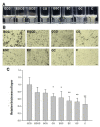
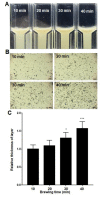
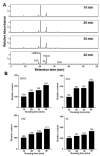
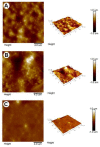

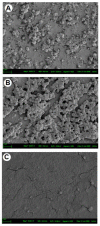

Similar articles
-
Quantitative analyses of the bitterness and astringency of catechins from green tea.Food Chem. 2018 Aug 30;258:16-24. doi: 10.1016/j.foodchem.2018.03.042. Epub 2018 Mar 12. Food Chem. 2018. PMID: 29655718
-
In vitro assay to estimate tea astringency via observing flotation of artificial oil bodies sheltered by caleosin fused with histatin 3.J Food Drug Anal. 2017 Oct;25(4):828-836. doi: 10.1016/j.jfda.2016.08.008. Epub 2016 Nov 5. J Food Drug Anal. 2017. PMID: 28987359 Free PMC article.
-
Effect and mechanism of calcium ions on the astringency in green tea infusion and epigallocatechin gallate solution: An in vitro oral soft tribology study.Food Chem. 2025 Jun 15;477:143442. doi: 10.1016/j.foodchem.2025.143442. Epub 2025 Feb 17. Food Chem. 2025. PMID: 39999546
-
Mechanism of Creaming Down Based on Chemical Characterization of a Complex of Caffeine and Tea Catechins.Chem Pharm Bull (Tokyo). 2016;64(7):676-86. doi: 10.1248/cpb.c16-00131. Chem Pharm Bull (Tokyo). 2016. PMID: 27373623 Review.
-
Multifunctional effects of green tea catechins on prevention of the metabolic syndrome.Asia Pac J Clin Nutr. 2008;17 Suppl 1:273-4. Asia Pac J Clin Nutr. 2008. PMID: 18296354 Review.
Cited by
-
Artificial oil bodies: A review on composition, properties, biotechnological applications, and improvement methods.Food Chem X. 2024 Jan 4;21:101109. doi: 10.1016/j.fochx.2023.101109. eCollection 2024 Mar 30. Food Chem X. 2024. PMID: 38268842 Free PMC article. Review.
-
Widely targeted metabolomic analysis reveals effects of yellowing process time on the flavor of vine tea (Ampelopsis grossedentata).Food Chem X. 2024 May 7;22:101446. doi: 10.1016/j.fochx.2024.101446. eCollection 2024 Jun 30. Food Chem X. 2024. PMID: 38846795 Free PMC article.
-
Enhancement of flavor components of oolong tea and dark tea based on graphene heating film.Food Chem X. 2025 Apr 3;27:102433. doi: 10.1016/j.fochx.2025.102433. eCollection 2025 Apr. Food Chem X. 2025. PMID: 40241702 Free PMC article.
References
-
- Shi J., Yang G., You Q., Sun S., Chen R., Lin Z., Simal-Gandara J., Lv H. Updates on the chemistry, processing characteristics, and utilization of tea flavonoids in last two decades (2001–2021) Crit. Rev. Food Sci. Nutr. 2021;13:1–28. - PubMed
-
- Hara Y. Elucidation of physiological functions of tea catechins and their practical applications. J. Drug Food Anal. 2012;20:296–300. doi: 10.38212/2224-6614.2096. - DOI
-
- Wang S., Zeng T., Zhao S., Zhu Y., Feng C., Zhan J., Li S., Ho C.T., Gosslau A. Multifunctional health-promoting effects of oolong tea and its products. Food Sci. Hum. Well. 2022;11:512–523. doi: 10.1016/j.fshw.2021.12.009. - DOI
MeSH terms
Substances
Grants and funding
LinkOut - more resources
Full Text Sources
Research Materials

